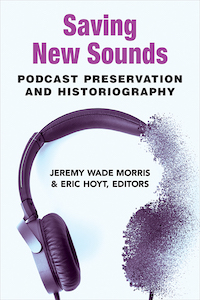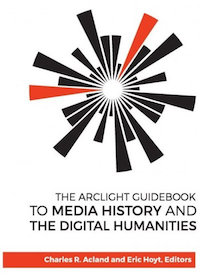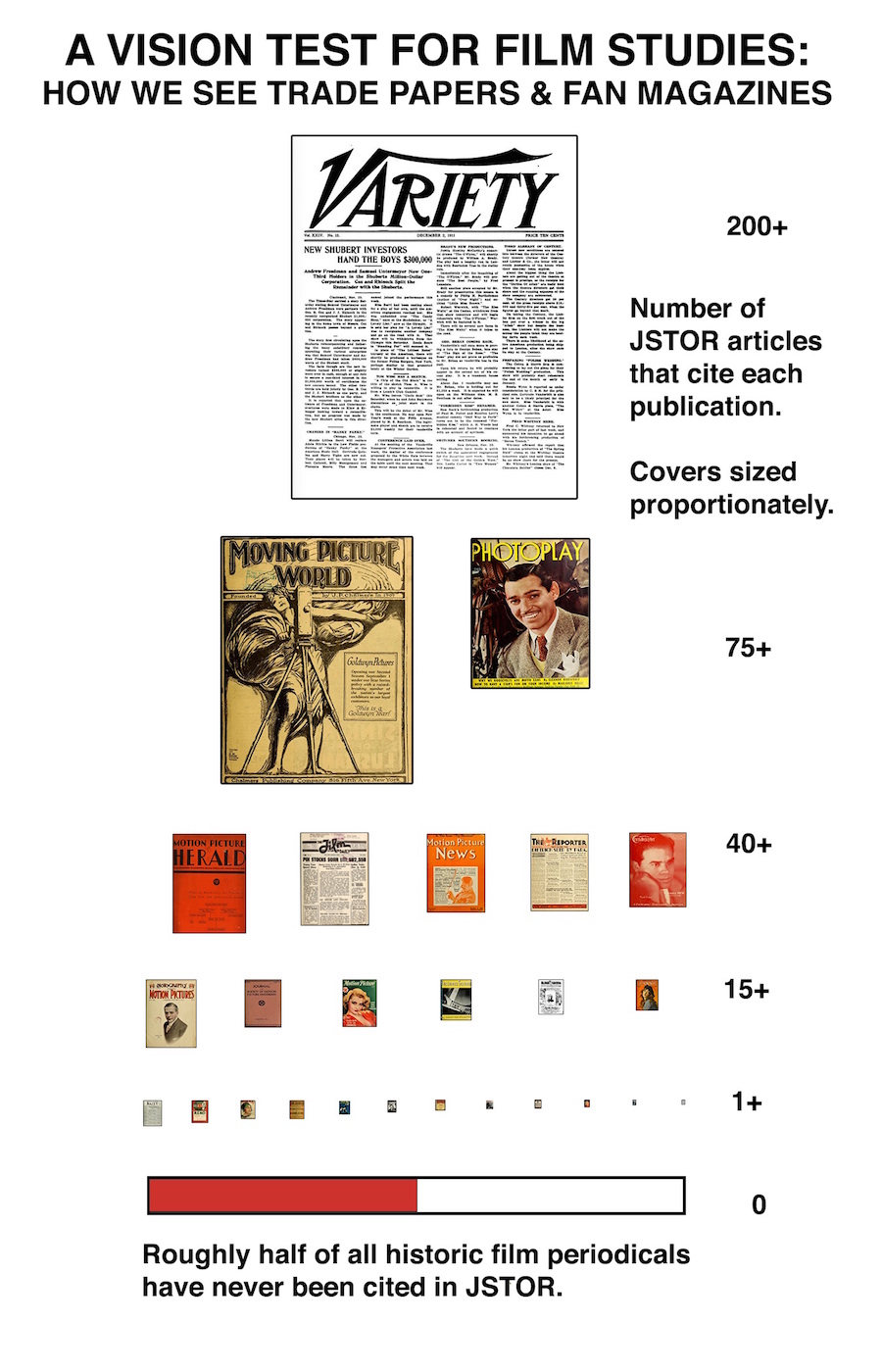
My books and an infographic are featured below. My journal articles, book chapters, and other publications are listed on my CV.

Between 1915 to 1935, no American industry had more trade papers reporting on and influencing its actions than the movie business. During this period, the American film industry consistently had a dozen or more national trade papers reporting on and influencing its actions. Additionally, many more regional trade papers profiled film production, distribution, and exhibition. In 1930, Exhibitors Herald publisher Martin Quigley conspired with the Hollywood studios to eliminate all the competing trade papers, but he ultimately failed. Ink-Stained Hollywood: The Triumph of American Cinema's Trade Press (University of California Press, 2022) is the story of why this and numerous other attempts at consolidation during this period were unsuccessful.
Ink-Stained Hollywood examines the period of the film industry trade press’ greatest diversity and heterogeneity—from the early feature film era in the mid-1910s to the mid-1930s. By chronicling the histories of well known trade papers (e.g. Variety and Hollywood Reporter) alongside many important yet forgotten publications (e.g. the pro-labor Film Spectator and Camera!, which was run entirely by women for two years), my book challenges the established canon of film periodicals and makes the case that we should regard the millions of pages published by the trades as some of Hollywood’s greatest productions. The book argues that a diverse trade press triumphed by appealing to the unique aspects of Hollywood’s culture, including taste, partisanship, and community gatekeeping. In the process, the trades produced our rough draft of film history and even some lines of poetry, like Variety’s 1935 headline, “Sticks Nix Hick Pix.”

Hollywood Vault: Film Libraries before Home Video (University of California Press, 2014) is the story of how the business of film libraries emerged and evolved, spanning the silent era to the sale of feature libraries to television. Eric Hoyt argues that film libraries became valuable not because of the introduction of new technologies but because of the emergence and growth of new markets, and suggests that studying the history of film libraries leads to insights about their role in the contemporary digital marketplace.
The history begins in the mid-1910s, when the star system and other developments enabled a market for old films that featured current stars. After the transition to films with sound, the reissue market declined but the studios used their libraries for the production of remakes and other derivatives. The turning point in the history of studio libraries occurred during the mid to late 1940s, when changes in American culture and an industry-wide recession convinced the studios to employ their libraries as profit centers through the use of theatrical reissues. In the 1950s, intermediary distributors used the growing market of television to harness libraries aggressively as foundations for cross-media expansion, a trend that continues today. By the late 1960s, the television marketplace and the exploitation of film libraries became so lucrative that they prompted conglomerates to acquire the studios.
The first book to discuss film libraries as an important and often underestimated part of Hollywood history, Hollywood Vault presents a fascinating trajectory that incorporates cultural, legal, and industrial history.

Over seventy-five million Americans listen to podcasts every month, and the average weekly listener spends over six hours tuning into podcasts from the more than thirty million podcast episodes currently available. Yet despite the excitement over podcasting, the sounds of podcasting’s nascent history are vulnerable and they remain mystifyingly difficult to research and preserve. Podcast feeds end abruptly, cease to be maintained, or become housed in proprietary databases, which are difficult to search with any rigor. Podcasts might seem to be highly available everywhere, but it’s necessary to preserve and analyze these resources now, or scholars will find themselves writing, researching, and thinking about a past they can’t fully see or hear.
Edited by Jeremy Wade Morris and Eric Hoyt, Saving New Sounds: Podcast Preservation and Historiography gathers the expertise of leading and emerging scholars in podcasting and digital audio in order to take stock of podcasting’s recent history and imagine future directions for the format. Essays trace some of the less amplified histories of the format and offer discussions of some of the hurdles podcasting faces nearly twenty years into its existence. Using their experiences building and using the PodcastRE database—one of the largest publicly accessible databases for searching and researching podcasts—the volume editors and contributors reflect on how they, as media historians and cultural researchers, can best preserve podcasting’s booming audio cultures and the countless voices and perspectives podcasting adds to our collective soundscape.

From the tremendous video libraries of YouTube and the Internet Archive to the text collections of the HathiTrust and the Media History Digital Library, media historians today confront the challenge of engaging with an abundance of cultural works that have been transformed into data. What new skills, competencies, and tools do media historians and scholars need in an era of digital research?
Edited by Charles R. Acland and Eric Hoyt, The Arclight Guidebook to Media History and the Digital Humanities (REFRAME and Project Arclight, 2016) seeks to answer this question—and raise many more—by examining what media historians are doing right now with digital tools and methods. Across seventeen chapters, contributing authors discuss the ways in which they are using or building digital technologies, assessing strengths and weaknesses, and responding to successes and failures. Topics explored include search, maps, big data, text mining, video analytics, databases, networks, and new forms of publication. All authors attempt to be reflexive about how the media of the twenty-first century shape our engagement with the past.
By aggregating these perspectives, and including an index and a glossary of key terms, this collection seeks to be a “guidebook” that surveys what media historians are doing with digital tools and charts a course for how the field of media history might move forward in an ongoing dialogue with the digital humanities. This open access book can be freely downloaded from the Project Arclight website.

Since the earliest days of cinema, legal instruments, processes and institutions have influenced the conditions in which Hollywood films are made, sold, circulated and presented. From the talent contracts that enable a film to go into production, to the copyright laws that govern its distribution, or the censorship laws that may block exhibition, the law shadows cinema at every step. Meanwhile, the Hollywood film industry has left its own impression on the American legal system through lobbying to expand the duration of copyright, providing a highly visible stage for contract disputes, and representing the legal system on screen.
Hollywood and the Law (BFI/Palgrave, 2015), edited by Paul McDonald, Emily Carman, Eric Hoyt, and Philip Drake, brings together cinema and legal scholars to address key topics at the intersection of Hollywood and law, including copyright, trademark, piracy, antitrust, contracts, labor, and tax.
I created this infographic to present new data and make an argument: film historians need to look beyond the canon of familiar periodicals and explore the wider range of sources. Most of my research, videos, and work on digital projects tie back in some way to the goals of challenging our assumptions about media history and providing new analytical frameworks for historical research.

Credit: This infographic first appeared in Eric Hoyt, “Lenses for Lantern: Data Mining, Visualization, and Excavating Film History’s Neglected Sources,” Film History 26, no. 2 (Summer 2014): 146—168. I retain the rights to the image, but others are welcome to share it and reuse it -- so long as it's done on a non-commercial basis and attribution is provided.